Bathroom - room where high temperature is required. Firstly, feelings so comfortable, secondly, warm air will faster will carry out excessive humidity after taking a shower or bath. Heating in the bathroom makes infrequently not accepted. A more common way is to install a heated towel rail, which will talk about. So that everything worked without problems, you need to properly select the connection scheme, and it is also correctly implemented. And in all you will have to deal with yourself. After all, even if you do not do everything with your own hands, you will have to follow the plumbing. This can only be sure that you will leave a normally working dryer.
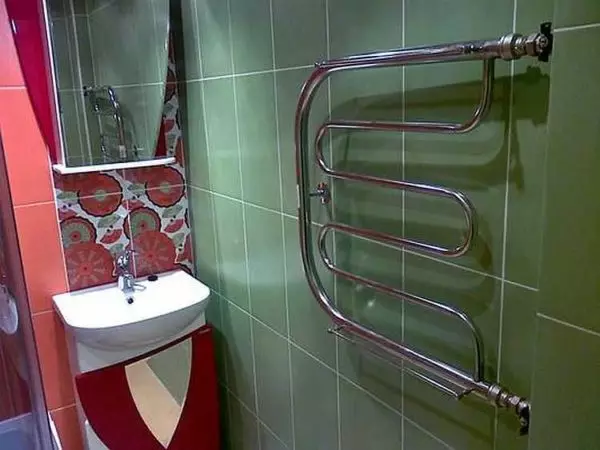
So that everything is not only looked well, but also worked without problems, you need to put the liner
What designs are there
Heated towel rails are different forms. With their choice, people are often guided exclusively aesthetics, which is not entirely justified. These instruments are normally working with good water circulation, but not all models provide such circulation. With some, it is necessary to wise long, looking for the correct connection scheme, otherwise they simply refuse to work.
So, all heated towel rail can be divided into four groups:
- P-shaped or U-shaped. Simple models, elementary connection (lateral). Ideally, if you find the model with the same mid-sieve distance when replacing the old one. Then, if you're lucky, you can not even redo the taps.
- Lestenka. Modern designs with some crossbar. Also a good option from the point of view of hydraulics. Connection can be the bottom, side or diagonal. But it is not chosen not arbitrarily, but for the totality of the conditions (where does the feed, the location relative to the riser).
- Snake. Another classic model with side connections. Installing a heated towel rail of this type, as a rule, no problems represent.
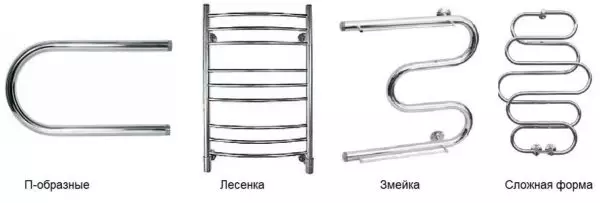
Types of towel rails
- Complex form. There are very unusual heated towel rails. They can even be an interior decoration, but their competent connection is a problem. As a rule, consultation is required for a competent specialist, plumbing, which is well oriented in hydraulics. As you understand, find such - the task is not easy.
It often happens that after installing the heated towel rail, it simply does not work. If the error is serious, the riser is also stopped working to which it is connected. Therefore, you need to know and execute the connection rules.
Where to connect and where to hang
You can connect a water heated towel rail to hot water riser and heating. If there are both of these options, it is usually chosen by the DHW. There are three reasons for this: fewer troubles with a connection permissions can be connected at any time of the year (agree on the management of the turning off of the riser and all) and, most importantly, the heated towel rail is heated all year round.
If the DHW is not in the house, you will have to connect to the heating riser. This requires permission of the Criminal Code and the project. Buy a heated towel rail (preferably simple design), go to the hob with his passport (copy), write a statement. If the resolution is given, order the project (also need a copy of the passport with the co-socitating dimensions). Then, according to the project, perform themselves or hire the performers (plumbers from the Hweak, as an option). Call an assistant to acceptance.

To the "Towel" warmer always and without problems, all the submarines are straight, without arcs and pockets
When determining the installation site of the towel rail, questions may still have questions about what height should be hung. If there is a choice, it is most convenient to have it so that it is at the head level and below. This is if you put a P-shaped or snake. If we are talking about "ladders" of a high height, the upper bar have no level of glow raised hand (approximately 190-200 cm).
When choosing a place of installation of a towel rail, you must still take into account the distance from the riser. In principle, the closer to the riser, the better it is more likely to work. But, it is possible to attribute to the meter or so, only when performing conditions:
- Small hydraulic resistance of the heated towel rail (simple shape and section 1 "or 3/4"),
- sufficient pressure (2 atm or more)
- Wallow pipes of normal diameter (one step less than the riser).
At the same time, it is necessary to fulfill other rules for the connection. Then there will be chances and the fact that the device will work normally.
What to make taps and how to change the riser
If the riser is metallic and you are not going to change it, the installation of a heated towel rail is possible with steel or polypropylene pipes. If the riser you change (the best option) and put polypropylene, there is no choice - the PPR tubes go to the taps. Polypropylene take for hot water, better - reinforced fiberglass.
Why does not fit metal plastic? Because he has the fittings with a strong alignment of the lumen. It affects the circulation very badly. As a result, even 100% workable schemes do not give normal heating.
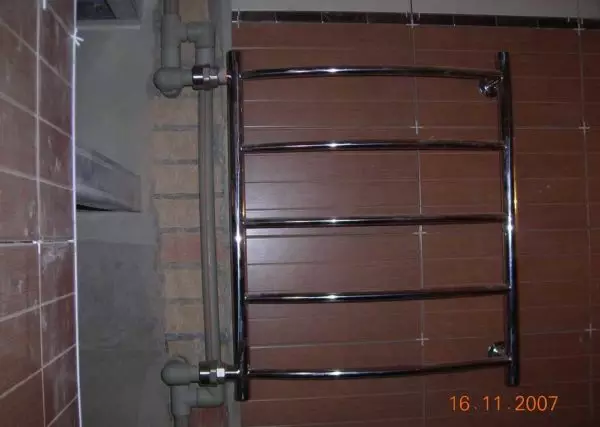
Installing a towel rail with polopropylene tubes
A little about why change the riser. It makes sense to do in old houses when repaired in a bathroom or bathroom (depending on where you have a standing). First, the pipes are usually old and worn. Even the removal is even problematic to privacy, so metal worn out. Secondly, modern repairs involves a hidden gasket of communications and you too want to close the riser. Hold the old tube, and after a few years everything is repeated again ... Not the best solution.
A little about how to change. You need to agree with the neighbors from below and from above, as well as with the JCEC (DEZ, CC). With the neighbors that you will cut the riser and on the thread, install a new one. Why do they have? Because leave the old pipe in the overlap is dangerous: collapsed and flows. Floods you or neighbors from below. Therefore, it is better through the overlaps to go through a new pipe.
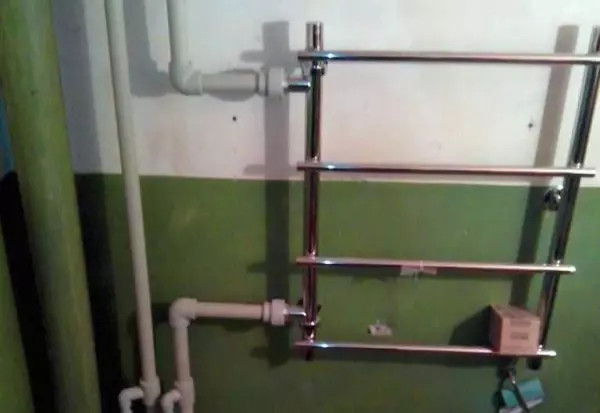
With such a connection, the dryer is part of the riser and no cranes be
Having arranged or not with the neighbors (they can have a closed riser) go to the HOS and agree on the date of replacement and time to which the riser is turned off. Local locksmith can work, you yourself (in the presence of a welder's qualifications) or people hired by you. After the insertion, the water includes, you check the working capacity of the heated towel rail and the system as a whole. If in 30 minutes it does not start cooling, then it is delivered correctly. On this, the replacement or installation of the heated towel rail is completed.
With bypass or without
Let's start with what is bypass. This jumper between the input and the output of the device, which ensures the circulation of water when the instrument is output or its disconnection.
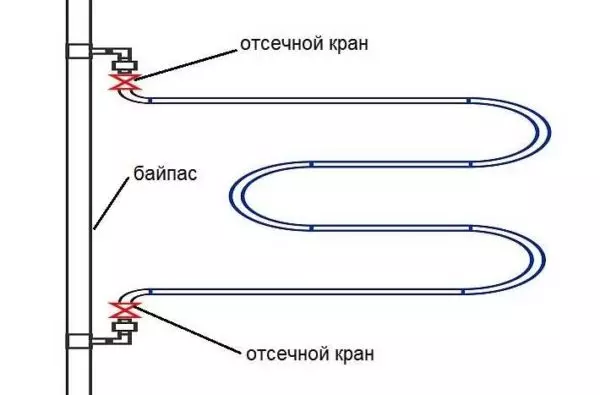
The jumper between the entrance and the output of the towel rail and there is bypass
If there is a bypass with the diagram, you can install shut-off ball valves at the input and output of the device. This is convenient - you can disable if necessary (during repair or replacement) and do not overlap the entire riser.
If there is no such jumper, it is impossible to install any cranes. In this case, the heated towel rail is part of the riser, closing the cranes you completely overlapping the riser.
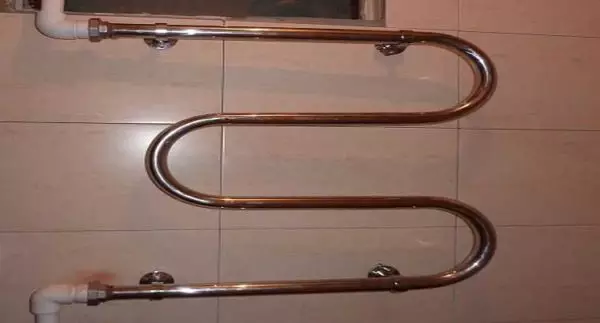
When connected without bypass, no cranes
Bypass can be direct (as on the first photo in chapter) or shifted (in the photo below). The displaced jumper is set at the top of the coolant feed for better operation (the circulation is improved). At the bottom feed, the offset only interferes. If you do not know where water is served, it is better to make a direct bypass.
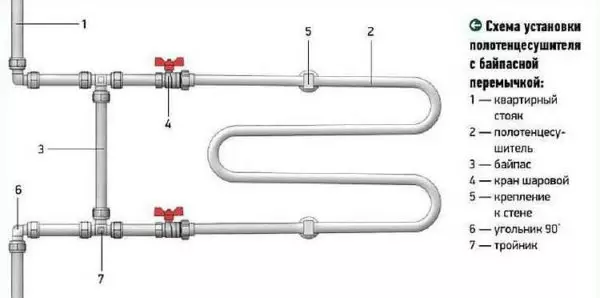
The displaced bypass at the top of the coolant supply improves circulation
More bypass (straight or displaced) are made alone. Selling, as well as the offset improves circulation, but only in the case of the upper feed. Seasonings make a pipe that is less than the main one (if the inch is inch, a narrow place is made 3/4 "). Less can not. Insert size is at least 10 cm.
Once again: displaced and / or narrowed bypass works only at the top of the water supply. At the bottom it hinders the circulation. If you are not sure, make bypass direct and outrageous.
It is categorically impossible to put cranes on the bypass. Each crane is the loss of pressure, which means that it worsens the circulation of all the riser, the water flows no longer so hot. All neighbors above or lower (depends on the direction of the feed) the pressure is noticeably deteriorated. Sometimes it falls as the owner of Bypassa with a crane. To all, it is an absolutely unnecessary detail that brings only harm, and there is no noticeable improvement in circulation in the heated towel rail. Well, and in addition, this is a violation of SNiP 31-01-2003 (P 10.6) - interference in general communitudes, for which a fine may be discharged (considerable).
How to place taps (connection methods)
With lateral and diagonal connections, the taps should be located at one level with the inputs of the towel rail or slightly above / lower. What exactly will not work, so this is the installation of a towel rail if the taps are located at a distance of less than the distance between the inputs. In the photo below, an example of a non-working diagonal connection with close removal. Black is marked with an option for its corrections (the upper supply).
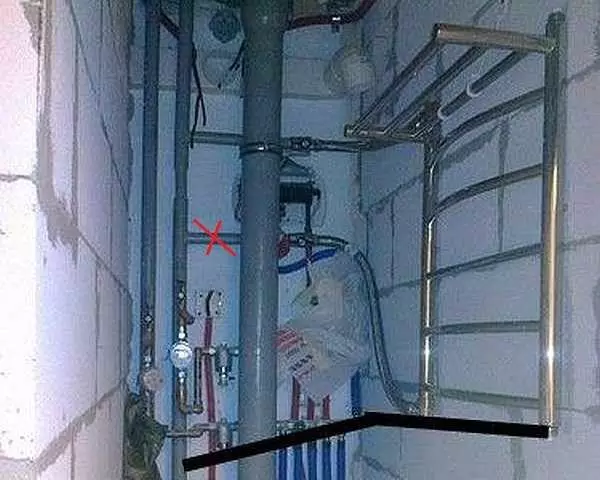
In the lateral connection, the heated towel rail will work only if the taps are slightly higher and slightly below its inputs or at least at one level
When connected, it is necessary to have taps strictly horizontally or a bit at an angle. A bit at an angle is from 2 cm per meter (2%) or can be slightly larger. The direction of the slope depends on the connection scheme and to which end this removal will be connected. To be slightly clearer, consider several typical circuits for connecting heated towel rails.
Universal Lower Connection of the Lanenka Heated Towel
This scheme works regardless of the direction of hot water supply. Connection type - bottom, both removal should be located lower than the bottom edge of the dryer. At the top of the feed, let's say an option when the edge is between the discharge, but the work may not be so effective (it can be worse).
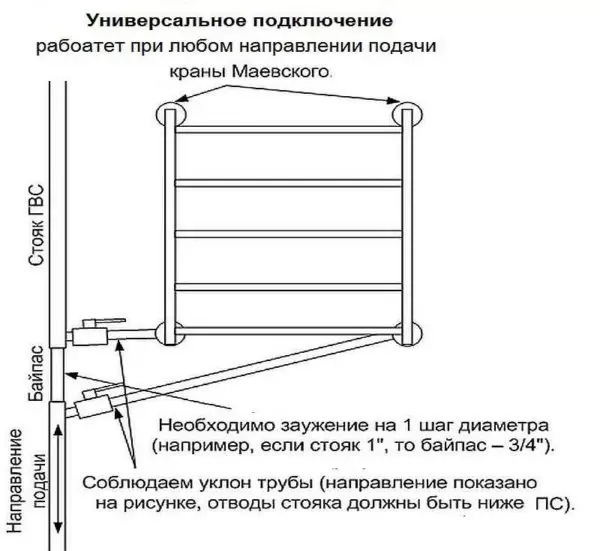
Universal connection of the heated towel rail (Lower)
In this diagram you can install shut-off cranes. For its normal operation requires:
- Mounted on the upper leads of the cranes of Maevsky (air ventilateers) to descend accumulating in the upper part of the air. They will need to periodically open and lower the air (as it starts to warm it worse). There is an option - put automatic air vent. They also have compact. It will simplify operation.
- Bypass direct with searches. Size of sediments - pipe for one step of smaller diameter.
- Taps are performed by a pipe on a step of smaller diameter than the main riser.
If you have a height of this option, make it. The scheme operates in all conditions, with heated towel rails like "Lanenka" of any kind.
Possible Nizhny Connection Option
When spilling hot water from above, you can make the upper removal above the bottom edge of the dryer. With the displaced bypass and his searches should be warm up fine. This method is not the best, but working.
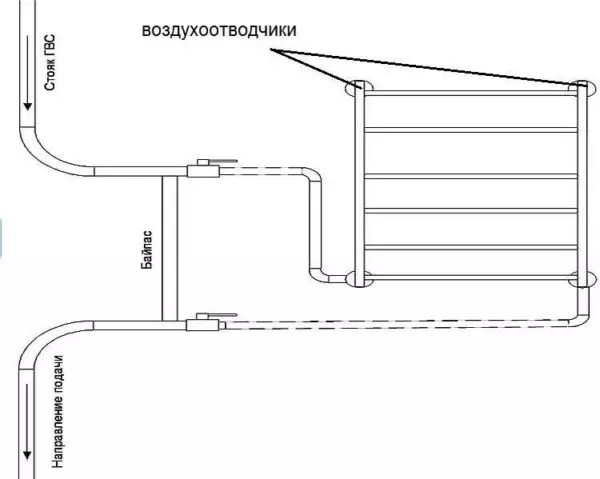
Working option with top spilling hot water
The presence of air droplets and air booming after the system is stopped - mandatory.
Universal side connection
You can bring the pipe on the side of the Tilt of any of the standard forms - P-shaped, snake and ladder. Connection itself on the form depends. In the standard version there is a straight out of mind bypass. Taps or strictly horizontally or with a slight bias. The slope is in the picture: the end of the top outlet is tilted slightly down (2 cm per 1 meter), the bottom - stroke a little up. The diameter of the taps is not less than the diameter of the heated towel rail.
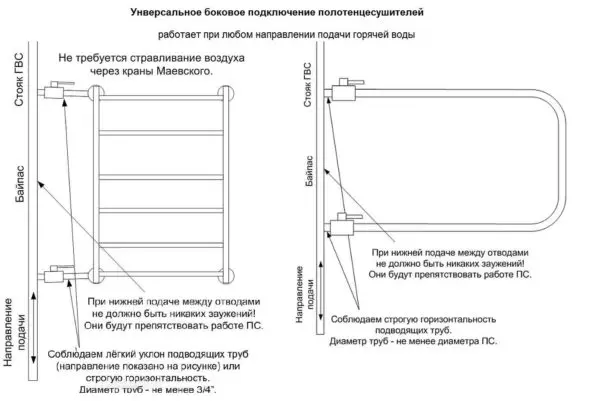
Side Universal Connection of Heated Tower
A similar connection scheme is good because there is no need to install air vent (put the plugs), as the air simply goes into the riser.
With the upper feed on the bypass, it is possible to make alignment and / or shift the jumper towards the towel rail. It will improve the circulation, the dryer will warm up better. But again: this scheme will work only at the top of the water supply.
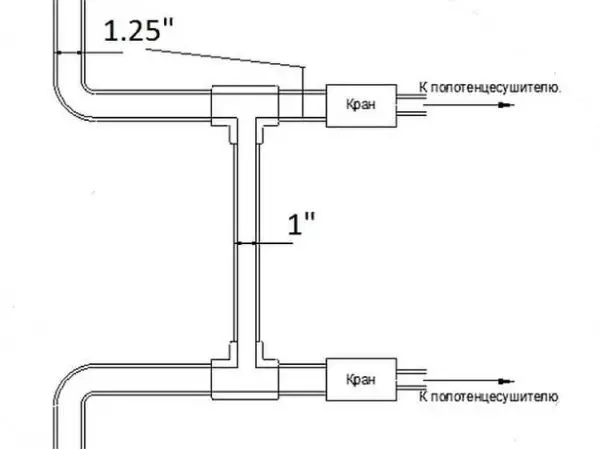
When the water is supplied from above, the bypass can be shifted and make it a pipe on a step of smaller diameter
With such a scheme, you can also make taps under a slight inclination or strictly horizontally.
Possible side connection option (not the best)
The lateral connection scheme with the location of the top removal is below the top edge of the heated towel rail. But with such a connection, Maevsky cranes are needed through which air will have to burst after turning off the DHW to repair / prevention. You may also need periodic air removal in the process.
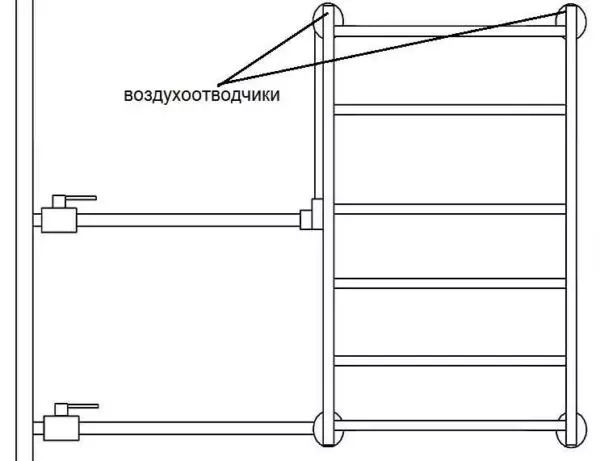
Not the best, but quite efficient option
Diagonal connection
There is no particular sense in the diagonal connection of the majority of heated towel rails: their efficiency from the side is no different (in any case there is no significant improvement), and the flow consumption is more, and the lobes are also required, and this is laborious. Although the scheme is operational.
Diagonal works normally if the water supply goes from above. Then the upper removal is connected to the far edge of the "ladder", and the bottom to the neighbor.
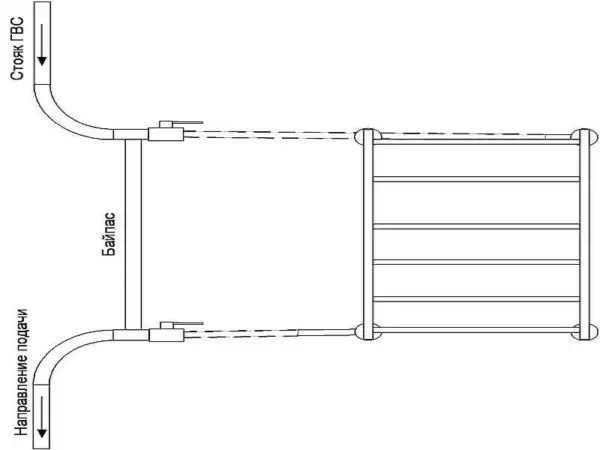
Diagonal connection at top feed
In this case, too, you can also do a narrowed and biased bypass, but without this everything should work "with a bang." With the lower supply of bypass without searches, exactly on the riser, connection
Close-in-shaped heated towel rails: how to connect
In the case of connecting toweling devices of complex form, in addition to ordinary means, it is also necessary to take into account the features of the structure of each specific model. They should be considered from the point of view of hydrodynamics - where water will be better to flow, there and feed water. For example, the popular model "Elegy" company SUNERGA. This is not a staircase and not Zig-knocked.
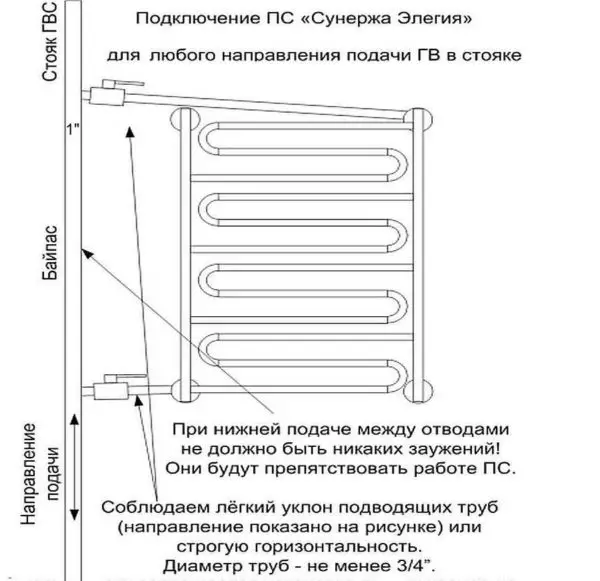
There is a diagonal connection, because another simply will not work
Installing a heated towel rail Side Sunerios chosen lateral, since with any other circulation will be broken. There are no options at all.
Another model - with the lower connection and complex design, has three installation options. Under the condition of water supply from above, the best will work best, a little worse - the first, the most intact - the third one.

Nizhny connection options with upper spill
When submitting below, the option 1 and 3 remains, but only without aligning bypass - it will interfere, and not help. The second option is excluded completely.
How can not do
All schemes presented above work stably. As you notice, all the taps go straight, without bends in the form of an arc or rings. This is not by chance - in all irregularities, air accumulates, which interferes, and sometimes, and completely overlaps the circulation.
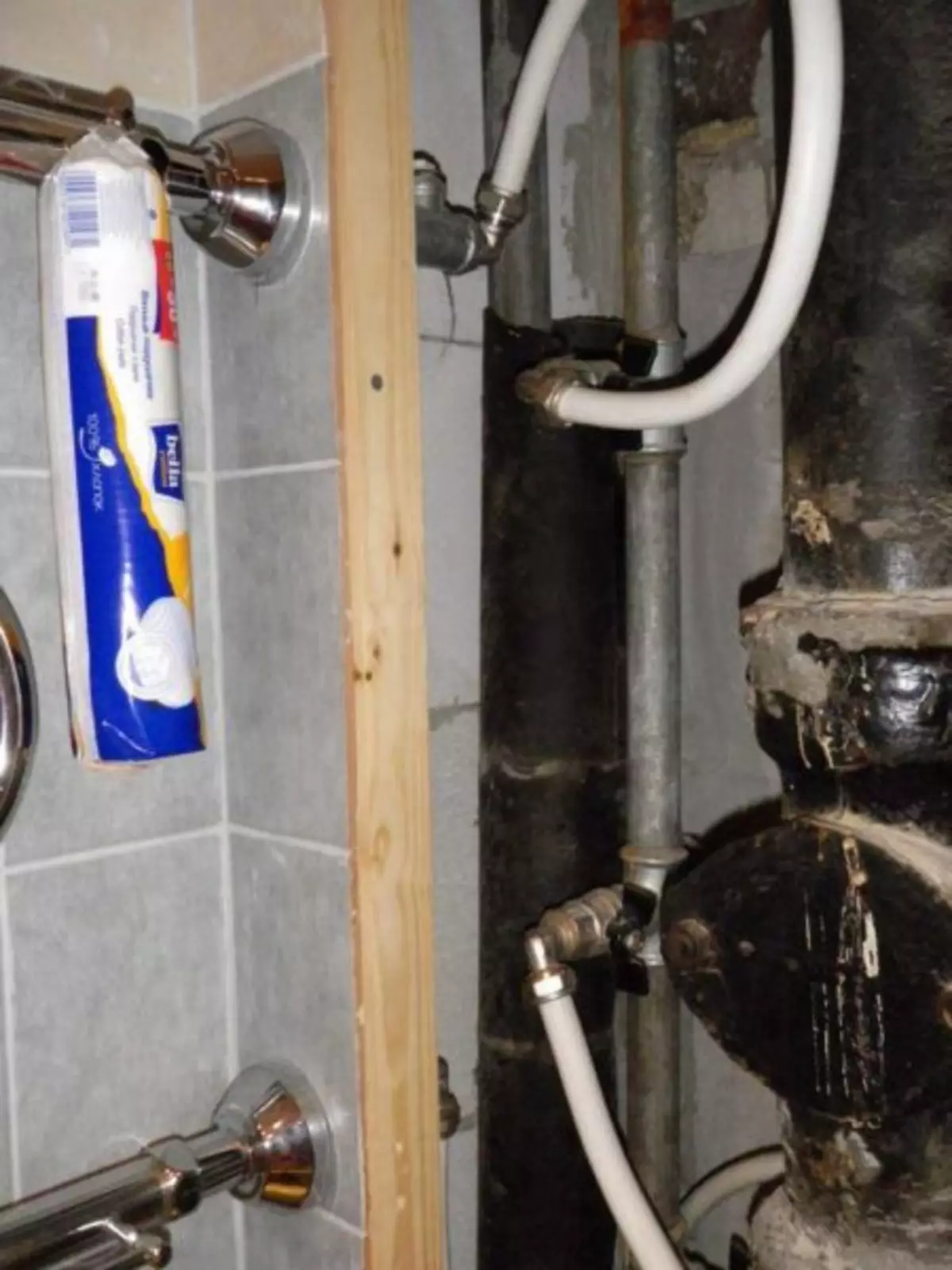
This scheme does not work
In the photo installation of the heated towel rail is incorrect. Made at least two mistakes:
- The taps have already been made than the mid-scene distance of the heated towel rail;
- They are made by a metal-plastic pipe with hinges.
This connection simply cannot work. Metal-plastic pipes are excellent material, but not for connecting heated towel rails. Their fittings have a very strong alignment of the lumen, which is badly affected by circulation. Plus, air accumulates in the hinges, as well as the stream along the upper loop, even when serving from above, will not go - too large hydraulic resistance to water should be overcome.
Unstable schemes
The following two schemes can work, but not always. At the bottom of the heated towel rail, water is stirred and, with some difference of heights, can not rise. To say specifically when it will work, and when no, no one can. Depends on the pressure in the riser, from the diameter of the pipes and the design of the dryer itself.
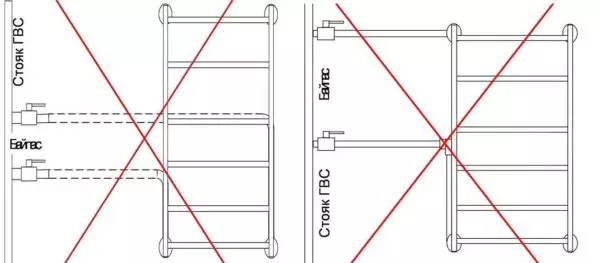
Unstable Connection Schemes
With such a connection, even a working connection may suddenly stop working after stopping). Everything is simple: the pressure has changed, the pipes clogged, the water from below does not "pushing", the heated towel rail does not heat.
Another version of the unstable scheme is from the loop from above. Again, under some conditions it will work. But sooner or later the highest point is delivered and blocks circulation. The trouble can help, if you install automatic air vent, but when the pressure drops and it does not save.
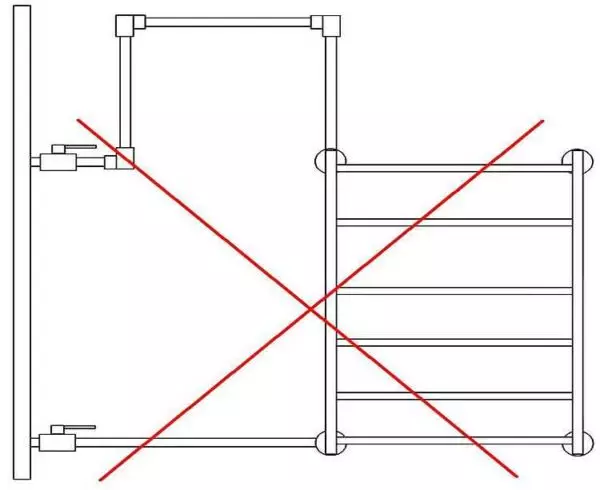
With loop from above
Completely incorrect
In the photo below, examples of how to do not need. Schemes without crane on the bypass are inoperable. What it threatens - it is known. In addition, after several years of operation, they will no longer function. Most likely this will happen after another shutdown - the system will score mud. All because the entire flux of hot water is broken through a heated towel rail. After repairing the water carries a huge amount of dirt, which safely settles in bends (in the lowest sections in the first place). For several years everything is clogged completely. For a good, everything is required to remake and connect correctly, but it can only help the grinding.
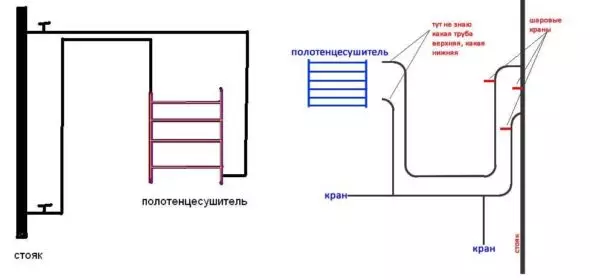
Very bad idea
It is necessary to rinse a heated towel rail and the supply to it. For this, the dryer is removed and mine in the bathroom, and we wash the taps alternately by connecting the hose to the released outputs, the second end of which to withdraw into the sewer. Manipulating the cranes to skip the stream of hot water through one removal, then through the other. After washing everything is installed in place. It may be possible to run after this system.
Mounting process
Connecting a heated towel rail to ready-made discharges standard for plumbing - suitable fittings, flax and packaging paste or fum-tape. For mounting to the wall there are brackets or special clamps-holders in which the pipe is pressed. The process is shown in detail in the video.
Article on the topic: How to open the interior door handle: Step-by-step instructions
